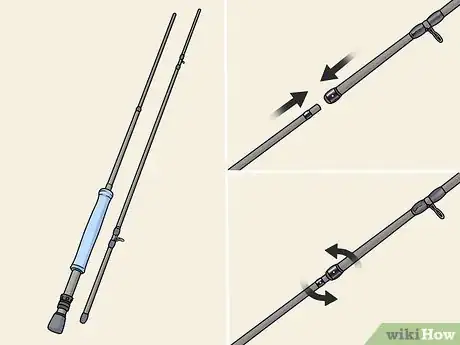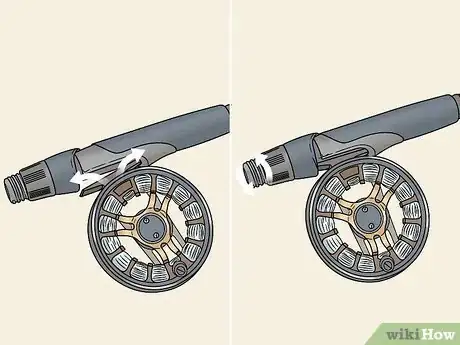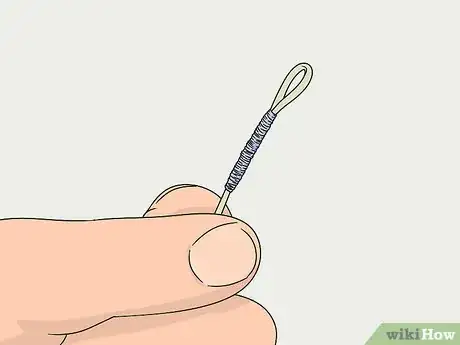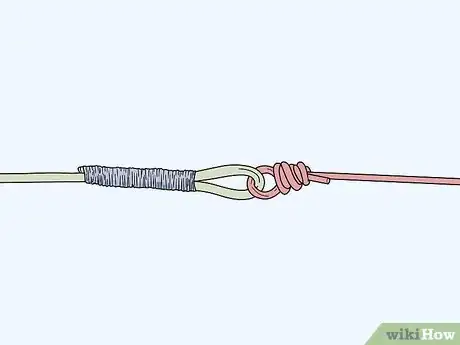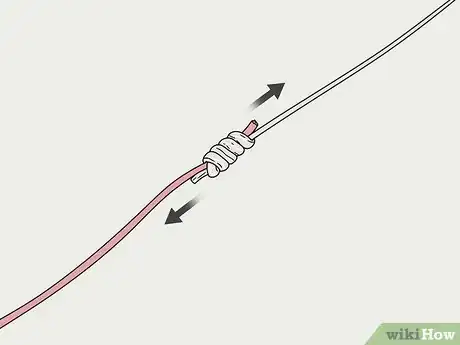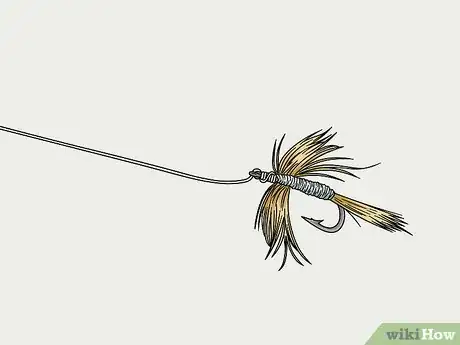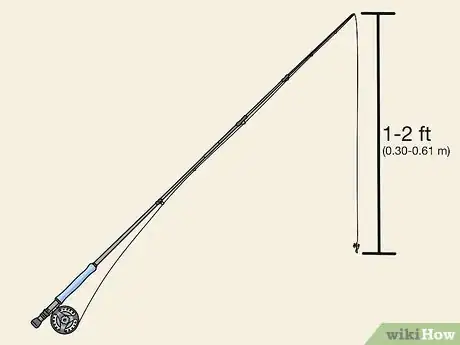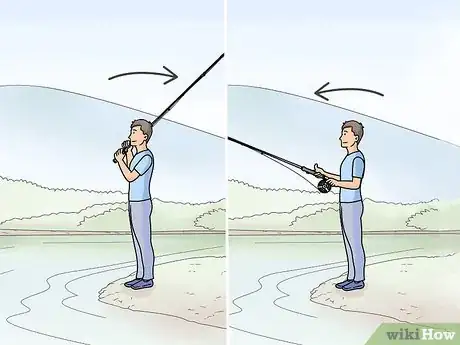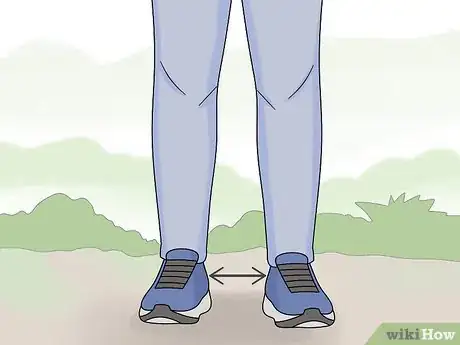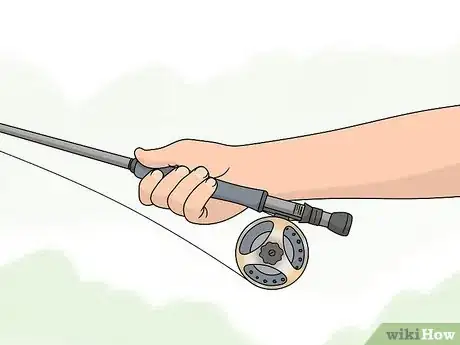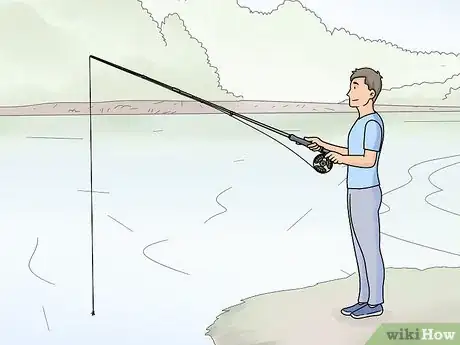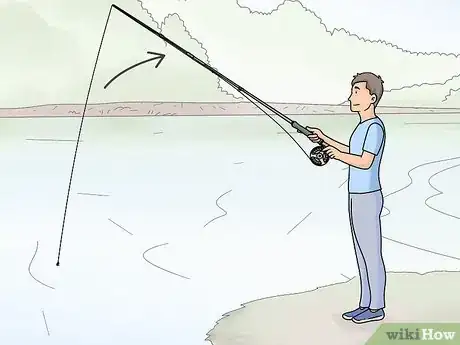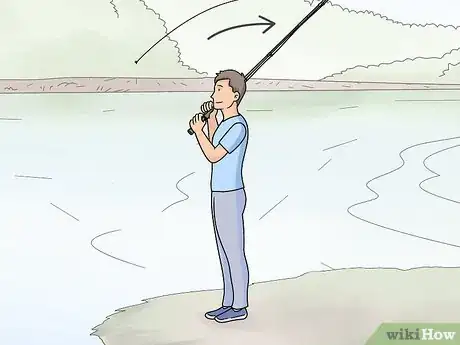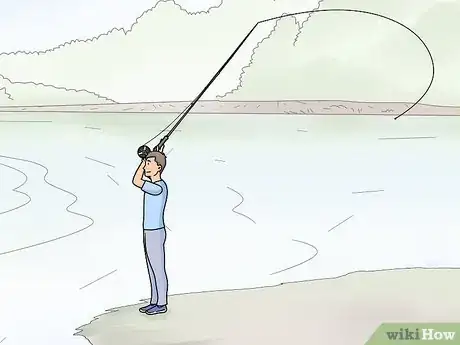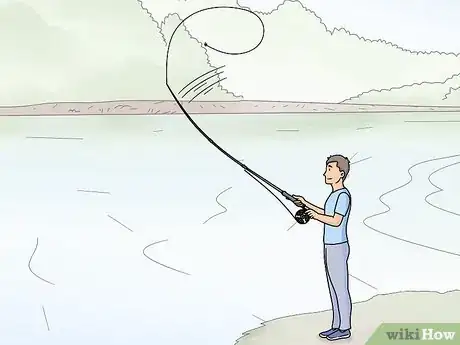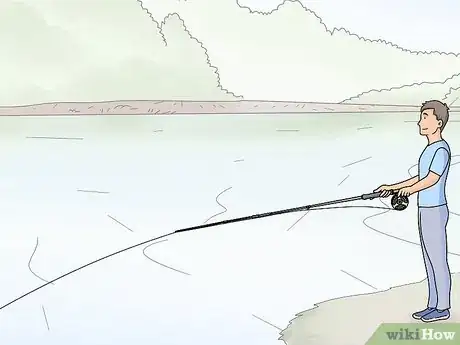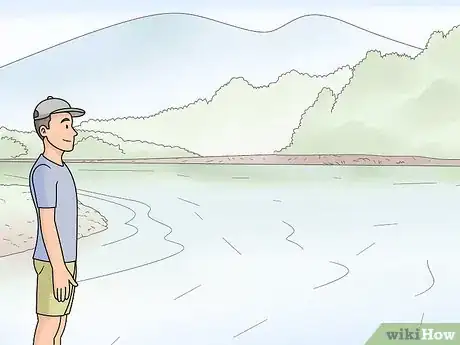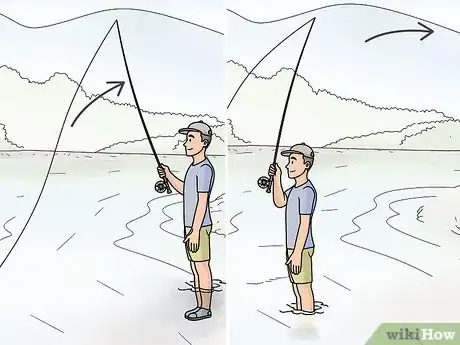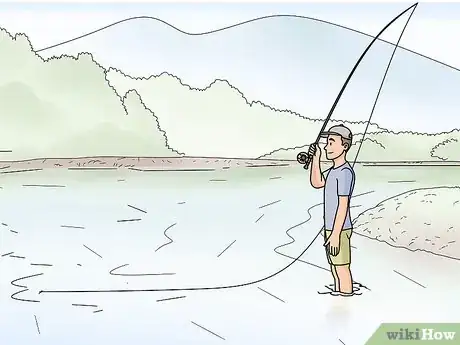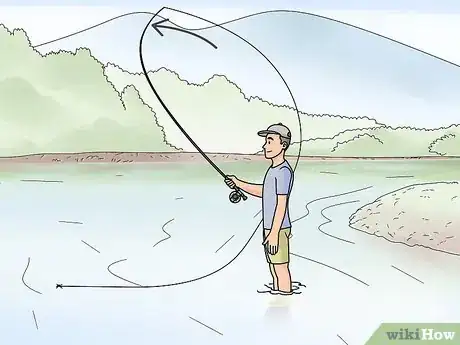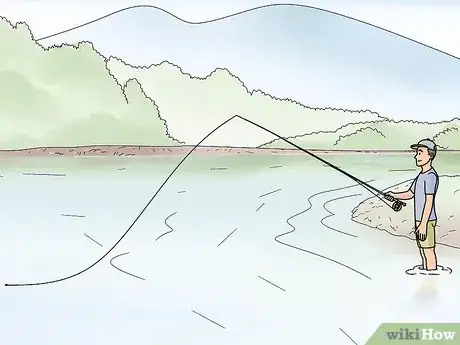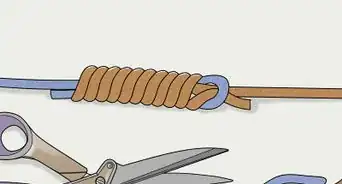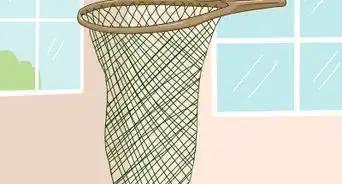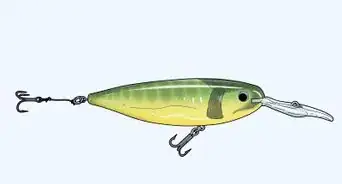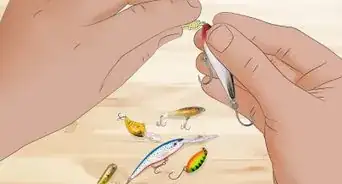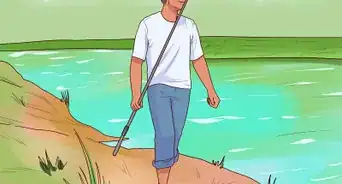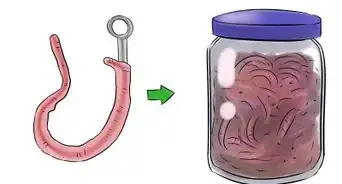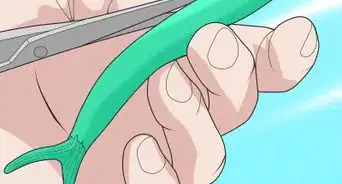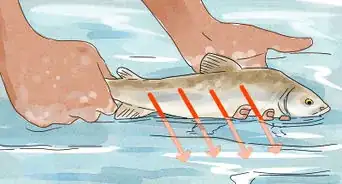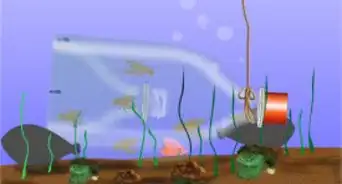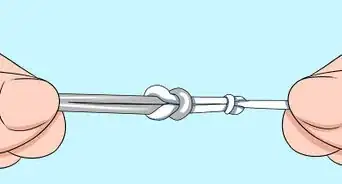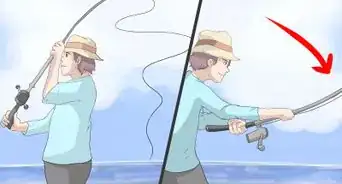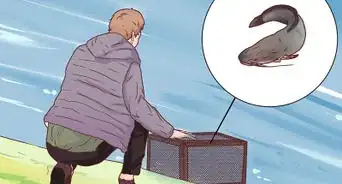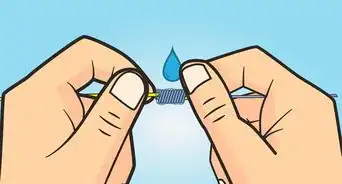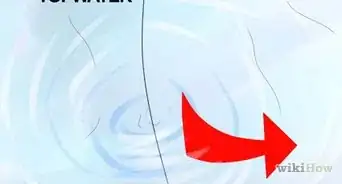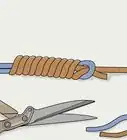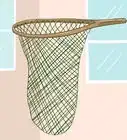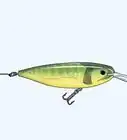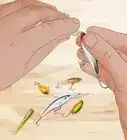This article was co-authored by Michael Reynolds. Michael Reynolds is a Professional Fishing Instructor and the Owner of Long Beach, California Fishing Lessons by Michael Reynolds. In his over 40 years of fishing experience, Michael has become very knowledgeable about the variety of fishing methods and techniques. He is passionate about sharing his knowledge with beginners to experienced anglers. Michael has been guiding and teaching fishing for over five years and is licensed and bonded with the Department of Fish and Wildlife (DFW).
There are 11 references cited in this article, which can be found at the bottom of the page.
wikiHow marks an article as reader-approved once it receives enough positive feedback. This article received 11 testimonials and 83% of readers who voted found it helpful, earning it our reader-approved status.
This article has been viewed 190,600 times.
Fly fishing can be as challenging as it is fun. Learning how to cast with a fly rod takes lots of practice to master, but the basic technique is actually pretty easy to understand. Start by adjusting your line so it's rigged up properly to allow for a good cast. Then, try your hand at using the overhead cast. Once you master the basics, you can try using a roll cast to approach fish quietly and in harder to reach places!
Steps
Putting the Fly Fishing Rod Together
-
1Put together the segments of the fly fishing rod. Take the rod out of its case. Start with the 2 bottom pieces of the rod, which will be the largest ones. Slide the 2 pieces together and gently twist them to line up the 2 dots on the side. Then, slide the remaining pieces into the rod and line up the 2 dots of each section.[1]
- Don't force or twist the rod segments too hard or you could crack them.
- The segments will get thinner down the length of the rod.
-
2Slide the reel into the reel seat at the bottom of the rod. The small divot at the bottom of the rod is called the reel seat and is meant to hold the reel in place. Attach the reel to the rod by sliding the foot of the reel into the small opening at the top of the reel seat. Then twist the nut at the bottom of the reel seat to tighten it over the reel.[2]
- Wiggle the reel around to make sure it's securely attached.
Advertisement -
3Make a loop knot at the end of the fly line.[3] You'll use the end of the fly line to connect the leader (the thin line that connects the thick fly line to the tippet and fly lure) and tippet (an even thinner line that is nearly invisible to the fish and holds the fly lure) so you can string your lure. Give yourself plenty of slack in the fly line and form a loop knot at the end of it so you can easily attach the leader and change it out later if you want to.[4]
- Make sure the fly line is spooled tightly on the reel so it's less likely to form knots.
-
4Connect the leader to the end of the fly line with a fishing knot.[5] The leader is a length of line that is used to transition from the thick fly line on the rod to the thin tippet that holds the lure. The leader starts thick at the end connected to the line and tapers down to a smaller line where it connects to the tippet. Tie a fishing knot to connect the leader to the fly line at the thicker end.[6]
- The leader also keeps the line from slapping the water and spooking the fish.
- The leader should be at least 9 feet (2.7 m) long to allow for adequate separation between the heavy fly line and the fly lure.
- Some leaders have metal clasps that you can use to attach to the loop in the fly line.
-
5Fix a tippet to the end of the leader by tying it securely with a knot. A tippet is a very thin line that attaches to the fly at one end and the leader at another. It's supposed to be nearly invisible in the water so the fish don't see the line connected to the fly. Connect a tippet to the end of the leader so it's secure and you can add a fly to the end of the tippet.
-
6Attach a fly lure to the end of the tippet with a sturdy knot. The fly has a small hook on it that will snag the fish that takes the bait. Pass the tippet through the eye opening of the hook and use a fishing knot to connect the lightweight fly to the end of the tippet. Moisten the line to make it more pliable so you can tie a tighter knot.[8]
Tip: Give a good tug on the tippet and the leader to straighten them out and make sure they're secure.
-
7Set the fly line about 1–2 feet (0.30–0.61 m) longer than the fishing rod. The weight of the fly line is what allows you to cast, so you need to have enough of the heavier line pulled out before you try to cast. An easy way to ensure you have enough fly line is to let out enough to reach the reel at the bottom of the rod with about 1–2 feet (0.30–0.61 m) of extra length.[9]
Casting Overhead
-
1Use an overhead cast to get used to casting a fly fishing rod. The overhead cast is the standard fly fishing cast. Mastering the overhead cast requires knowing how to properly “load” the rod, which refers to finding the tension in the line and pole to cast the fly lure. Before you move on to more advanced casts, learn to use the overhead cast.[10]
- The overhead cast is harder to perform when there are lots of low hanging branches because the line can get tangled easily.
-
2Stand with your feet shoulder-width apart. For short to medium ranged casts, adopt a parallel stance so you're stable and in a better position to “feel” the weight of the fly line on the rod. Keep your feet evenly spaced apart and your weight centered rather than on the balls of your feet or your heels.[11]
- For longer casts, you may feel more comfortable standing with 1 foot forward so you can reach further behind you for a stronger cast without losing your balance.
-
3Hold the rod with your thumb on top of the grip.[12] Don't squeeze too tightly or you won't be able to perform the quick stop at the end of the stroke. Keep a loose, comfortable grip and hold the rod in line with your intended target area.[13]
- Allow the rod to rest in your fingers and only squeeze the grip when you force it to stop at the end of each stroke.
- Keep the butt of the fly rod in line with your forearm.
- Make sure the reel of the rod is pointed down toward the ground.
-
4Lay the line straight on the ground in front of you. In order to generate enough momentum in your backswing, start by stretching out about 10 feet (3.0 m) of the line from the end of the rod. Aim the line completely straight and stand square to your target.[14]
- Make sure that the leader and tippet don't get tangled up.
-
5Bring the rod up and backward in 1 motion. Keep the tip of the rod low until you're ready to cast and use a smooth and fluid motion to bring the rod up and behind you. This will cause the rod to bend and load up with tension.[15]
- Think about snapping a long whip. The line should move up and overhead as it travels behind you in a large arc.
-
6Stop the rod abruptly once it passes a verticle position. When you straighten the rod out above your head and it passes behind you, stop its acceleration abruptly and deliberately so the line is launched behind you. Hold the rod still as the line travels backward.[16]
- Think about stopping the rod at about the 1 or 2 o'clock position behind you.
-
7Allow the line to unroll in the air behind you. With the rod still extended above and slightly behind you, wait for the line to travel behind you and rise as it unrolls. The energy from the backward motion will cause it to move until it extends completely.[17]
- Make sure you pause long enough to allow the line to fully unfurl.
Tip: If the line falls short before it completely unrolls behind you, you may not have put enough energy or power in your cast. Straighten the line back out in front of you and try again!
-
8Move the rod forward to bring the line in front of you. As soon as the line is fully extended in the air behind you, use a smooth, accelerating stroke to bring the rod forward. The line will snap forward and form a loop in the air as it travels.[18]
- Keep your wrist straight and your elbow close to your body to generate a fluid movement.
-
9Lower the tip of the rod as the line unrolls in front of you. Stop the rod once it's about parallel with the ground to allow the energy in the line to propel it forward. As the line unrolls in front of you, slowly lower the tip of the rod to roll the line out all the way to the fly at the end. The line should end right where you were aiming.[19]
- Don't snap the rod down sharply or the tension in the line could cause the cast to go straight down before it has reached its target.
Performing a Roll Cast
-
1Use the roll cast when you're fishing in narrow waterways. The roll cast will cause the line to smoothly unroll over the surface of the water and is less likely to disturb fish, but it's also a little more difficult to perform. It's also important that the line is in water because the water anchors it and allows you to create a loop.[20]
- A roll cast is great to use when you're fishing in narrow creeks or streams.
- The roll cast is also effective if you have a strong wind at your back that is interfering with your overhead cast.
-
2Draw the rod up and back to drag the end of the line across the water. Start with about 25 feet (7.6 m) of line laid out in front of you on the water and the tip of your rod pointed at the surface. Use a slow and smooth motion to bring the rod back and drag the line over the surface of the water.[21]
Tip: Make sure you don't pull the line out of the water. The friction of the line and the water is what loads the rod and allows you to cast it forward.
-
3Stop the stroke with the rod tip high when a loop has formed behind you. As soon as your rod reaches just past a vertical position, stop and hold it in position. The line should be slack and droop behind the tip of the rod, creating a loop.[22]
- The larger the loop, the more power you can generate to cast the line forward.
-
4Accelerate the rod forward quickly. Once you've formed the loop with the backward motion, quickly move the rod forward to start the forward cast. Keep your hand high and the rod pointed up. The line will start to roll over the surface of the water and move the direction of your cast.[23]
- Move forward with a smooth and consistent movement rather than a short and jerky motion.
-
5End the cast by stopping abruptly to allow the line to unroll. As you move your rod forward, the loop will rise up. Stop your cast abruptly once it's nearly parallel with the water. The loop will roll out on top of the water and move to where you're aiming your cast.[24]
- Allow the end of the line to land gently on the surface of the water.
Expert Q&A
Did you know you can get expert answers for this article?
Unlock expert answers by supporting wikiHow
-
QuestionHow do I get a better fly cast?
 Kathy Sparrow, MAKathy Sparrow is a fly-fishing instructor and adventurer at heart. Kathy is the co-founder and previous manager of the Kingfisher Inn, a fly-fishing lodge on the Lower Laguna Madre in Texas. She is the author of "On the Mother Lagoon: Flyfishing and the Spiritual Journey" and "The Whispered Teachings of Grandmother Trout” a novel conveying the feminine perspective of fly fishing. Kathy is also a Certified Canfield Trainer in Canfield Methodologies. She guides individuals through the process of embracing change by expressing confidence, awareness, and courage through the tools of writing, fly fishing, and intentional conversation. She has a MA in English with an emphasis in Literature and Cultural Studies from the University of Texas-Pan American.
Kathy Sparrow, MAKathy Sparrow is a fly-fishing instructor and adventurer at heart. Kathy is the co-founder and previous manager of the Kingfisher Inn, a fly-fishing lodge on the Lower Laguna Madre in Texas. She is the author of "On the Mother Lagoon: Flyfishing and the Spiritual Journey" and "The Whispered Teachings of Grandmother Trout” a novel conveying the feminine perspective of fly fishing. Kathy is also a Certified Canfield Trainer in Canfield Methodologies. She guides individuals through the process of embracing change by expressing confidence, awareness, and courage through the tools of writing, fly fishing, and intentional conversation. She has a MA in English with an emphasis in Literature and Cultural Studies from the University of Texas-Pan American.
Fishing Instructor
-
QuestionHow do I prepare the line for fly fishing?
 Dennis J GwinCommunity AnswerThe heavy casting line should need no prep. It should be clean and float well. Consider wiping a light coat of pure silicone on twenty feet of the line starting ten foot back from the tip. This helps the line slide through the fly rods line guides. Use a barbed eyelet to attach the mono filament to the casting line,, these are sold in most tackle stores (picture a short sewing needle with barbs along the shaft pointing back toward the eye). You can slide the point into the hollow casting line. Loop the mono filament through the eye and tie a clinch knot. This will give you a streamline knot that will pull easily through the water when starting a back cast.
Dennis J GwinCommunity AnswerThe heavy casting line should need no prep. It should be clean and float well. Consider wiping a light coat of pure silicone on twenty feet of the line starting ten foot back from the tip. This helps the line slide through the fly rods line guides. Use a barbed eyelet to attach the mono filament to the casting line,, these are sold in most tackle stores (picture a short sewing needle with barbs along the shaft pointing back toward the eye). You can slide the point into the hollow casting line. Loop the mono filament through the eye and tie a clinch knot. This will give you a streamline knot that will pull easily through the water when starting a back cast. -
QuestionWhat is double pull casting?
 Dennis J GwinCommunity AnswerBegin the cast by pulling line in with your left hand while lifting the rod with your right. This gives the fly line additional momentum. Trap the fly line between the index finger of your right hand and the fly rod handle. This allows you to reach forward with your left hand and grab another length of fly line. When the line has straightened out begin you, once again pull in fly line. This adds momentum to your forward cast. When most of the line is once more in front of you,release the line in your left hand and it will play out. Timing is crucial.
Dennis J GwinCommunity AnswerBegin the cast by pulling line in with your left hand while lifting the rod with your right. This gives the fly line additional momentum. Trap the fly line between the index finger of your right hand and the fly rod handle. This allows you to reach forward with your left hand and grab another length of fly line. When the line has straightened out begin you, once again pull in fly line. This adds momentum to your forward cast. When most of the line is once more in front of you,release the line in your left hand and it will play out. Timing is crucial.
Things You'll Need
- Fly fishing rod
- Fly fishing reel
- Fly fishing line
- Tippet
- Leader
- Fly lure
References
- ↑ https://youtu.be/CCONVJb8-SE?t=18
- ↑ https://youtu.be/CCONVJb8-SE?t=90
- ↑ Michael Reynolds. Professional Fishing Instructor. Expert Interview. 26 February 2021.
- ↑ https://blueridgemountainlife.com/fly-fishing-for-beginners-a-complete-guide/
- ↑ Michael Reynolds. Professional Fishing Instructor. Expert Interview. 26 February 2021.
- ↑ https://blueridgemountainlife.com/fly-fishing-for-beginners-a-complete-guide/
- ↑ https://news.orvis.com/fly-fishing/tuesday-tip-four-hot-tips-on-tippets
- ↑ https://www.flyfisherman.com/editorial/how-to-fly-cast-2/151833
- ↑ https://youtu.be/TAyj9KF_MQE?t=40
- ↑ https://www.flyfisherman.com/editorial/how-to-fly-cast-2/151833
- ↑ https://www.flyfisherman.com/editorial/how-to-fly-cast-2/151833
- ↑ Michael Reynolds. Professional Fishing Instructor. Expert Interview. 26 February 2021.
- ↑ https://www.flyfisherman.com/editorial/how-to-fly-cast-2/151833
- ↑ https://www.fix.com/blog/basic-fly-casting-techniques/
- ↑ https://blueridgemountainlife.com/fly-fishing-for-beginners-a-complete-guide/
- ↑ https://blueridgemountainlife.com/fly-fishing-for-beginners-a-complete-guide/
- ↑ https://blueridgemountainlife.com/fly-fishing-for-beginners-a-complete-guide/
- ↑ https://www.fix.com/blog/basic-fly-casting-techniques/
- ↑ https://www.fix.com/blog/basic-fly-casting-techniques/
- ↑ http://www.flyfishingforbeginners.com/techniques/casting/roll-cast/
- ↑ https://youtu.be/b3K15_T8aO8?t=27
- ↑ https://youtu.be/b3K15_T8aO8?t=27
- ↑ https://www.fix.com/blog/basic-fly-casting-techniques/
- ↑ https://youtu.be/b3K15_T8aO8?t=93
About This Article
To do a basic overhead cast with a fly fishing rod, stand with your feet shoulder-width apart and put your weight on the balls of your feet. Keeping your fingers relaxed, grab the grip above the reel with your thumb on top and your fingers facing down. Make sure the reel faces the ground and keep the butt of the rod lined up with your forearm. Lay out about 10 feet of line on the ground in front of you, then bring the rod up and back in one fluid motion. Just as the rod starts to pass behind you, stop it abruptly and let the line unfurl into the air behind you. Flip the rod forward to cast the line, then lower the tip of the rod until it’s parallel to the ground. This will help propel the line forward in the water. Keep reading to learn how to do a roll cast!
